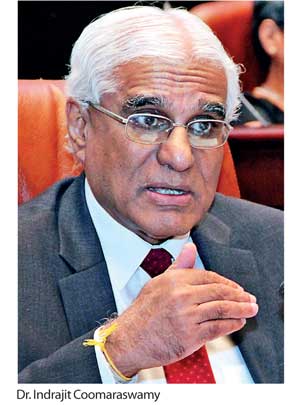29 Jun 2017 - {{hitsCtrl.values.hits}}
The prolonged drought and recent floods appear to have taken a toll on the country’s economy as the Central Bank last week said it would cut the growth of the economy at least by a half a percentage for 2017.
Although the country’s monetary authority is yet to formally revise down the growth forecast for this year, Central Bank Governor Dr. Indrajit Coomaraswamy said given these unexpected events, the country would fall short of meeting the originally forecasted growth for the year. 
He said Sri Lanka would be able to record a growth of around 4.5 percent to 5.0 percent compared to the original forecast of between 5.0 percent and 5.5 percent for 2017.
“We started the year by saying it would be about 5.0 percent. I don’t know whether we formally revised it as yet but my personal sense is that it will be somewhere between 4.5 percent and 5.0 percent because clearly when we made the forecast at the beginning of the year, we were not aware how severe the drought would be in the first couple of quarters. And then now we had the disruption due to floods,” Dr. Coomaraswamy told reporters in Colombo.
This is the second time the Central Bank has revised its growth projections for this year. Earlier, the Central Bank forecasted a growth of between 5.5-6.0 percent, which was revised down to 5.0-5.5 percent before this most recent reality check on the economy.
The World Bank in a report released in early June said the country’s growth would pick up to 4.7 percent the most in 2017 on the resumption of private investments, fiscal consolidation and improved investor sentiments as a result of the engagement with the International Monetary Fund (IMF).
During the first quarter of 2017, Sri Lanka’s economy grew by 3.8 percent, significantly lower than 5.3 percent in the final quarter of 2016 and 5.1 percent recorded during the same period last year due to the slowdown in the services and the contraction in the agricultural activities.
Dr. Coomaraswamy believes the growth for the first half of the year would not be higher than 3.8 percent before picking up to 5.0 percent or a little higher during the second half.
“Reconstruction and rehabilitation can give a bit of a bounce to the growth process in the second half of the year.
Now the first half of the year is going to end up about 3.8 percent growth. So, if we can have 5.0 percent or little higher, we could end up the year somewhere between 4.5 percent and 5.0 percent,” he added.
Despite the slowdown in the economy, Dr. Coomaraswamy said the government has put in place a strong economic foundation, which could be used as a springboard to create a positive business and investment climate by way of inking trade deals and implementing the government’s development programmes.
“My view is that the condition of the economy is improving. The macroeconomic fundamentals are becoming stronger. The government’s fiscal consolidation programme has been on track up to now, of course with the flood and things like that, that will have to be accommodated.
We feel that the current monetary policy stance by the end of the year will bring the inflation within our target range.
The exchange rate is gradually becoming more competitive and it may be only part of the reason why we are beginning to see some upturn in export performance.
The reserves are now little over US $ 7.0 billion and we expect to end the year with about US $ 7.2 billion.
Despite the setbacks caused by the drought and floods, I think the economy is in reasonably good shape. But one concern is the growth rate,” he added.
Meanwhile, for the first time in over a decade all major economies such as the United States, European Union, Japan, China and India are experiencing a synchronized growth, which Sri Lanka could use as a launch pad to increase exports and support its own growth.
26 Nov 2024 7 minute ago
26 Nov 2024 38 minute ago
26 Nov 2024 3 hours ago
26 Nov 2024 3 hours ago
26 Nov 2024 3 hours ago